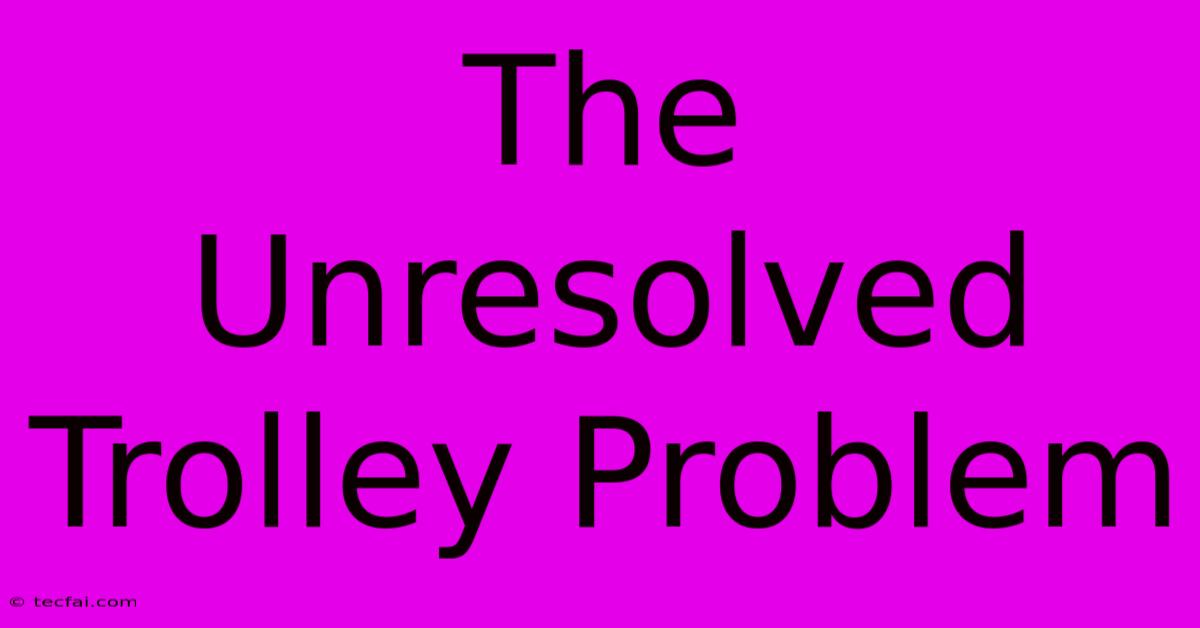The Unresolved Trolley Problem

Discover more detailed and exciting information on our website. Click the link below to start your adventure: Visit Best Website tecfai.com. Don't miss out!
Table of Contents
The Unresolved Trolley Problem: A Philosophical Minefield
The Trolley Problem, a classic thought experiment in ethics and psychology, continues to fascinate and frustrate philosophers and ethicists alike. Its enduring appeal lies in its ability to expose the complexities of moral decision-making, revealing the inherent conflicts between different ethical frameworks. While seemingly simple on the surface, the Trolley Problem's unresolved nature underscores the nuances and subjective interpretations inherent in ethical dilemmas.
Understanding the Trolley Problem's Core Dilemma
The basic premise is straightforward: a runaway trolley is hurtling down a track towards five unsuspecting individuals. You are positioned at a lever that can switch the trolley onto a side track, saving the five but sacrificing one person on that alternate track. Do you pull the lever?
This seemingly simple choice unravels into a complex web of considerations. The core conflict lies between utilitarianism, which emphasizes maximizing overall well-being (saving five lives over one), and deontology, which focuses on moral duties and rules, suggesting that actively causing harm (even to save others) is inherently wrong.
Variations and Their Impact
The power of the Trolley Problem comes from its numerous variations, each designed to probe different aspects of our moral intuition. These variations often subtly shift the context, forcing us to re-evaluate our initial responses. Consider these examples:
-
The Fat Man Variation: Instead of a lever, you are standing on a bridge overlooking the track. To stop the trolley, you could push a large man onto the tracks, sacrificing him to save the five. This variation introduces the element of direct action versus indirect action, often leading to different responses. Many find the act of pushing the man far more morally repugnant than pulling a lever, highlighting the impact of personal involvement.
-
The Transplant Problem: A healthy individual could be sacrificed to provide organs to save the lives of five patients. This variation moves beyond the impersonal nature of the trolley and forces consideration of the moral implications of violating bodily autonomy.
Why It Remains Unresolved
The Trolley Problem's enduring relevance stems from its lack of a definitive "correct" answer. Different ethical frameworks provide different justifications for action (or inaction), highlighting the subjective nature of moral judgments. Furthermore, the problem challenges our intuitive responses, revealing inconsistencies in our moral reasoning. We often find ourselves justifying different actions based on seemingly minor variations in the scenario, questioning the consistency of our moral compass.
The Psychological and Neurological Perspective
Recent research in psychology and neuroscience has added another layer to the Trolley Problem's complexity. Studies using fMRI scans have attempted to pinpoint brain regions associated with emotional responses and rational decision-making during the dilemma. While these studies offer intriguing insights into the neural processes underlying moral judgment, they haven't yielded a single, universally accepted explanation for the varied responses.
The Continuing Debate
The Trolley Problem isn't just an academic exercise; it has real-world implications in areas like self-driving car programming and military ethics. The ongoing debate forces us to critically examine our values, prioritize our moral compass, and grapple with the difficult choices we might face in the real world. The very act of engaging with the problem encourages deeper reflection on our own moral frameworks and the limitations of simple solutions to complex ethical issues. It remains a potent reminder of the enduring challenge of navigating moral uncertainty.

Thank you for visiting our website wich cover about The Unresolved Trolley Problem. We hope the information provided has been useful to you. Feel free to contact us if you have any questions or need further assistance. See you next time and dont miss to bookmark.
Featured Posts
-
Hospital Crisis A New Government Challenge
Dec 03, 2024
-
Rising Ppd Rates A Racial Breakdown
Dec 03, 2024
-
Devon Woman Extracts Own Teeth
Dec 03, 2024
-
Jonathan David Summer Transfer Watch
Dec 03, 2024
-
Post Super League 18 Free Agents Futures
Dec 03, 2024
